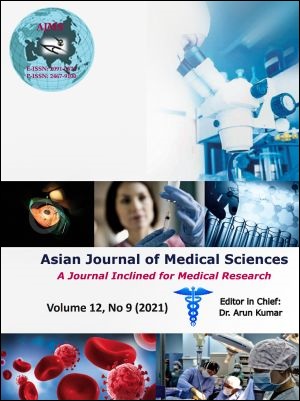Study of Absolute Neutrophil Absolute Lymphocyte count ratio in Community Acquired Pneumonia patients as a prognostic indicator at a tertiary care centre
Keywords:
Community acquired pneumonia, CURB65, COPD, Absolute neutrophil countAbstract
Background: Community acquired pneumonia refers to pneumonia contracted by a person with little or no contact with health care system. Following endotoxemia the number of circulating neutrophils increases while lymphocyte counts decrease. Combining both parameters seems a logical step and the ratio of neutrophil and lymphocyte counts is increasingly used in several clinical circumstances. Initially, this so-called neutrophil-lymphocyte count ratio (NLCR) was studied as an infection marker in ICU patients and found to correlate well with disease severity and outcome, according to APACHE-II and SOFA scores. In the current study, we explored the value of the NLCR in patients admitted with Community acquired pneumonia.
Aims and Objectives: 1) To find out the value of Neutrophil-Lymphocyte Count Ratio (NLCR)in Community Acquired Pneumonia (CAP). 2) To study Neutrophil-Lymphocyte Count Ratio (NLCR) as prognostic indicator in Community Acquired Pneumonia (CAP).
Materials and Methods: This prospective study was conducted on minimum of 100 patients admitted to hospitals from November 2015 to September 2017 from Bangalore. After admission of cases based on CURB-65 scores, a detailed history and clinical examination was done along with chest x-ray to establish the diagnosis. Before taking into the study all patients had signed the informed consent. Routine haematological investigations done on day 1,3 & 7 were carried out. Serum c-reactive protein levels, Urea nitrogen levels, Sputum for culture and sensitivity and Acid-fast bacilli (AFB) was done on the same day of admission. ANC (Absolute neutrophil count), ALC (Absolute lymphocyte count) and NLCR were calculated.
Results: Our study included age groups above 18yrs. Majority of the patients in the study were between 58-67 years (30%) followed by 48-57 years (27%). As the CURB-65 score increased from score 0 to score 4–5, the NLCR consistently increased, while the lymphocyte counts consistently decreased. In patients who died there was a significantly higher NLCR at presentation compared to patients that survived (15.18±3.55 versus 11.73±3.01, p-value,0.003).
Conclusion: In our study increased NLCR carried poor prognosis which correlated with high CURB65 score and ICU admission. In patients who died there was a significantly higher NLCR at presentation compared to patients those survived.
Downloads
Downloads
Published
How to Cite
Issue
Section
License
Copyright (c) 2021 Asian Journal of Medical Sciences

This work is licensed under a Creative Commons Attribution-NonCommercial 4.0 International License.
Authors who publish with this journal agree to the following terms:
- The journal holds copyright and publishes the work under a Creative Commons CC-BY-NC license that permits use, distribution and reprduction in any medium, provided the original work is properly cited and is not used for commercial purposes. The journal should be recognised as the original publisher of this work.
- Authors are able to enter into separate, additional contractual arrangements for the non-exclusive distribution of the journal's published version of the work (e.g., post it to an institutional repository or publish it in a book), with an acknowledgement of its initial publication in this journal.
- Authors are permitted and encouraged to post their work online (e.g., in institutional repositories or on their website) prior to and during the submission process, as it can lead to productive exchanges, as well as earlier and greater citation of published work (See The Effect of Open Access).




